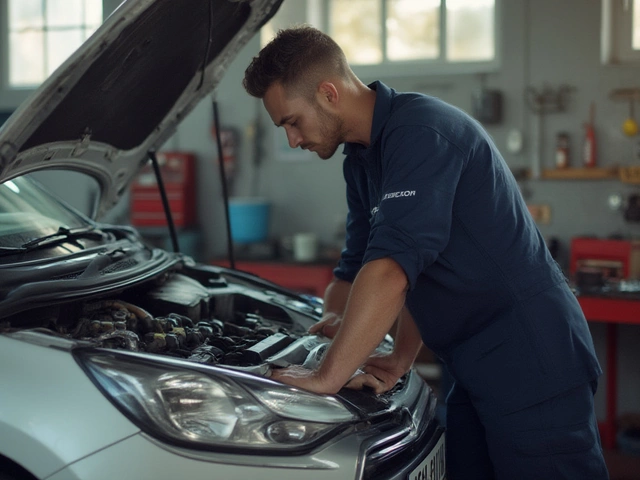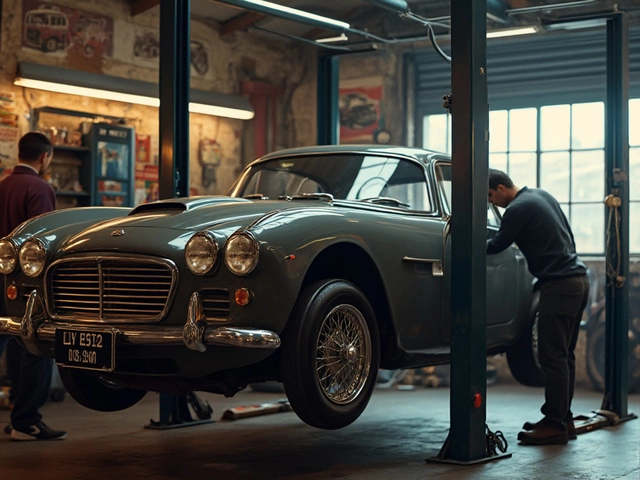Your car's brakes aren’t trying to keep secrets. If your brake pads are worn or bad, they're usually loud about it—literally. Hear a squealing every time you stop? That's the built-in wear indicator hitting the rotor, and it's your first clue that something’s up. If you ignore this noise, you might start hearing a grinding sound, which isn't just annoying—it's a sign the pads are nearly gone, and you're chewing up your rotors. Replacing rotors costs a whole lot more than just swapping out pads.
But it’s not all about sounds. Maybe the brake pedal feels mushy, or your car takes longer to stop. Or perhaps your steering wheel shakes when you brake at highway speeds. None of these should be ignored. Don’t chalk it up to ‘normal aging’—these changes mean your brake pads might be toast.
- Obvious Signs Your Brake Pads Need Changing
- What Strange Noises Really Mean
- How Brake Feel Changes When Pads Are Worn
- Inspecting Brake Pads Yourself: A Quick Guide
- Why Fixing Bad Brake Pads Matters
Obvious Signs Your Brake Pads Need Changing
Not sure if your brake pads are bad? Let’s look at the stuff you can quickly spot without being a mechanic. Most drivers notice one or two things start to change, and ignoring them usually doesn't end well for your wallet or your safety.
- Car Takes Longer to Stop: If you’re pressing the brake pedal down harder than usual but your car won’t stop as quick, that’s a big red flag. The stopping distance goes up big time with worn-down pads.
- Visible Thin Pads: If you peek between your wheel spokes, you should see a brake pad pressed against the brake disc. Less than 1/4 inch thick? That’s too thin and means it’s time for a change.
- Dashboard Warning Lights: Most newer cars have a brake warning light. If yours comes on—and you’re not low on brake fluid—chances are your pads are worn.
- Pulling to One Side: When you brake and the car veers left or right, it may mean the pads aren’t wearing evenly. That’s not just risky; it can mess with the whole brake system.
- Long Pedal Travel: If the pedal sinks closer to the floor before you feel the brakes bite, your pads could be toast or your system may have air in it. Either way, don’t wait around.
For some added clarity, check this quick table on how pad thickness relates to brake performance:
| Pad Thickness (inches) | Status | What to Do |
|---|---|---|
| 0.35+ | Healthy | No Action Needed |
| 0.25 | Getting Low | Plan to Replace Soon |
| <0.13 | Dangerously Low | Replace Immediately |
If you catch these warning signs early, you’ll avoid wrecked rotors and keep your car’s stopping power strong. Don’t ignore any of them—your brakes are the one system you always want 100% ready.
What Strange Noises Really Mean
Let’s talk about noise. Your brakes aren’t supposed to make music, so weird sounds usually mean it’s time to check your brake pads. That high-pitched squeal when you hit the brakes? Most modern pads come with a tiny metal tab called a wear indicator. When the pad wears down to a certain point, this tab scrapes the rotor and creates that screech. It’s not just there to annoy you—it’s a clear signal to act before things get worse.
If you start hearing grinding, it’s way more serious. Grinding almost always means the pad is worn completely down and now you’ve got metal clashing with metal. This causes damage to your rotors—think of it like running your shoes until there’s nothing left but your sock hitting the pavement. That gets expensive fast, and it’s not safe.
You might even pick up on a clunking or rattling noise while braking if the pads are loose or improperly installed. You shouldn’t ignore these sounds either, since a loose pad can mess up your braking and wear out parts faster.
Wondering how common these noises are, or what drivers report the most? Check this out:
| Noise Type | Main Cause | Percent of Brake-Related Issues (Based on Shop Reports) |
|---|---|---|
| Squealing | Wear indicator on pad | 55% |
| Grinding | Pad worn out, metal-on-metal | 30% |
| Clunking/Rattling | Loose or missing hardware | 10% |
| Other | Miscellaneous (dust, debris) | 5% |
So, if something doesn’t sound right, don’t put it off. Catching these noises early means you can save your rotors—and your wallet.

How Brake Feel Changes When Pads Are Worn
If your brakes suddenly feel weird underfoot, don’t just shrug it off. Worn-out brake pads mess with the way your brakes feel at every stop. It’s not subtle, either—most people notice something’s off before it gets truly dangerous.
Normally, your brake pedal should feel firm and stop your car with just a gentle press. When pads are going bad, the pedal can start feeling “mushy” or soft. Sometimes it takes longer to stop, and you might have to press the pedal deeper than usual. If things get really bad, you could feel vibrations or a pulsing in the pedal, especially when braking hard or at highway speeds.
Here’s what to pay attention to:
- Brake pads gone thin? Your pedal travel increases—you’ll naturally press further before you get any bite.
- Vibration or pulsing usually means your pads are uneven, or they’ve worn down to the point where metal is hitting metal.
- Spongy pedal feel can signal not just worn pads but also potential air in your brake lines—don’t ignore it.
- If your car pulls to one side when braking, one pad might be way more worn than the other.
Want some real numbers? According to a test by AAA, new brake pads can help stop a vehicle 20-30 feet sooner from 60 mph, compared to badly worn pads. That’s the length of two compact cars.
| Brake Pedal Feel | What It Could Mean |
|---|---|
| Mushy/Spongy | Pads worn out, fluid problem, or air in lines |
| Vibration/Pulsing | Pads uneven, possibly down to the metal backing |
| More Pedal Travel | Thin pads, pad wear, or hydraulic issue |
| Car Pulls When Braking | Worn pads on one side or a stuck caliper |
As Car and Driver put it,
“If the brake pedal no longer inspires confidence, worn pads are one of the first things to check—hesitation here can seriously affect stopping power.”
When you feel something off, don’t wait for things to get worse. If the pedal isn’t right, it’s time to investigate.
Inspecting Brake Pads Yourself: A Quick Guide
You don’t need to be a mechanic to check if your brake pads are worn out. You just need a flashlight and a little patience. First, take a look through the wheels—most cars let you see the brake pads right from the outside without taking anything apart.
Look for the pad pressed against the metal disc (that’s the rotor). A good rule of thumb: if the pad looks thinner than about 1/4 inch (that’s about the width of two stacked quarters), it’s time for a change. Some pads come with a built-in wear line or groove. If that groove is gone, the pad is worn out.
- Watch for uneven wear. If one pad looks way thinner than the other, or if the edges are more worn down, the caliper may be sticking.
- Check for cracking, crumbling, or shiny spots on the pad surface. Cracks mean the material is breaking down, and shiny (glazed) pads have overheated and lost stopping power.
- If your car has drum brakes (usually in the rear), you’ll need to remove the wheel and drum. Look for cracks or shoes worn thin—anything less than 1/8 inch is bad news.
If you’re not sure what you’re seeing, snap a photo and compare it to pictures online or ask a buddy who knows cars. Remember, a little check now can save you from a nasty surprise later.

Why Fixing Bad Brake Pads Matters
Letting bad brake pads slide can mess up more than just your car’s stopping power. The most obvious risk? Safety. If your brake pads are worn out, stopping distances jump up fast. In an emergency, those extra feet can be the difference between a close call and a crash. The National Highway Traffic Safety Administration points out that worn pads are a top reason for brake failure, behind faulty hydraulics.
Ignoring brake issues eats away at your wallet, too. Thin pads let metal grind against the rotor, turning a cheap pad swap into a much bigger repair job. Rotors aren’t meant to take that kind of heat and pressure from metal-to-metal contact, and you’ll end up replacing them way sooner than necessary. Plus, the stress from bad pads can warp rotors and ruin the calipers. None of these are cheap to fix, and waiting always makes the bill bigger.
Your car’s performance drops, too. Ever notice the steering wheel shaking or the car pulling to one side when you brake? That’s often a sign of uneven pad wear or heat-damaged rotors because someone rode on bad pads too long. Smooth, even brake pads keep your car stopping in a straight line and make sure ABS works like it should.
On top of that, not fixing bad brake pads can mess with your car’s reputation. If you’re planning to sell your ride down the line, a brake system that’s noisy or underperforming is a red flag for buyers. Keep records when you get the pads changed—it shows you looked after one of your car’s most important systems.
Bottom line: acting fast when your brake pads start going bad protects your safety, your cash, and your car’s long-term health. It’s really not something you want to gamble on.






